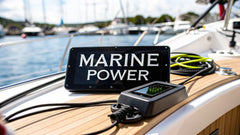A DIY Guide to Repairing a Boat Hull
Before you even think about mixing resin or grabbing a sander, the first—and most important—step is figuring out exactly what you're dealing with. A tiny crack might just be a cosmetic gelcoat issue, or it could be the tip of the iceberg, hinting at a much bigger structural problem hiding underneath. Getting this initial diagnosis right is everything. It’s the difference between a quick, lasting fix and a repair that fails when you need it most.
How to Assess Hull Damage Like a Pro
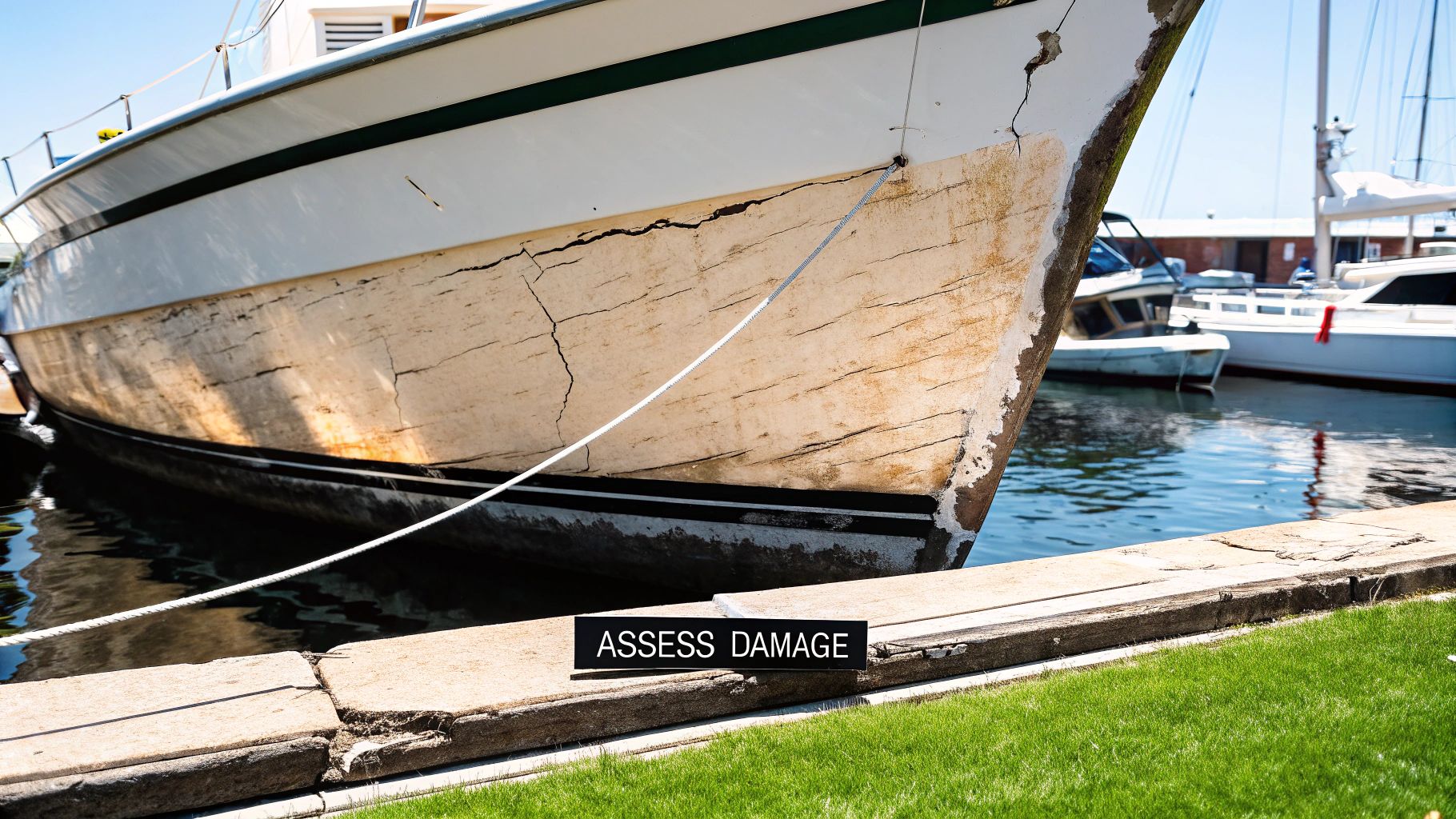
Think of yourself as a boat detective. You're looking for clues that tell the real story of your hull's health, separating minor scrapes from issues that could compromise your safety on the water.
This focus on proper inspection isn't just for weekend boaters; it's a massive global industry. The market for professional ship hull inspection services hit $3.45 billion, a number that's only going up thanks to strict safety rules and busy shipping lanes. While your boat might not be a supertanker, the principle is the same: a sound hull is a safe hull. You can read more about the growth of this vital market over at FactMr.com.
To get you started, here’s a quick-reference table to help you spot common issues across different hull materials.
Common Hull Damage Types and Their Telltale Signs
| Damage Type | Fiberglass Signs | Wood Signs | Aluminum Signs |
|---|---|---|---|
| Impact Damage | Deep gouges, star-shaped cracks, visible laminate fractures. | Dents, splintered planks, broken frames. | Dents, punctures, deep scratches, bent plating. |
| Structural Stress | Spiderweb or hairline cracks around fittings and high-flex areas. | Separated joints, loose or weeping fasteners, distorted planking. | Cracks near welds, especially around the transom or engine mounts. |
| Water Intrusion | Osmosis blisters (bumps on the gelcoat), dull thud in a 'tap test'. | Soft, discolored wood (rot), peeling paint, swollen planks. | Not directly applicable, but leads to corrosion. |
| Corrosion/Rot | Not applicable. | The primary threat; look for any soft, crumbly, or dark wood. | Pitting, chalky white powder (oxidation), especially near different metals. |
Think of this table as your initial checklist when you first haul the boat out. Now, let's dig into the specifics for each material.
Diagnosing Fiberglass Hull Issues
Fiberglass is tough, but it has its weaknesses. The two big ones you'll run into are stress cracks and osmosis blisters.
Stress cracks usually look like a fine spiderweb pattern. You'll often find them around high-stress points like cleats, stanchions, or winches where the hull naturally flexes. Most of the time, they’re just in the gelcoat and are cosmetic. But if you see deep, widespread cracking, especially on the transom or around the keel, it's time for a much closer look.
Osmosis blisters are a whole different beast. These are the bumps and bubbles you might see on the hull below the waterline. They’re a dead giveaway that water has worked its way through the gelcoat and is causing the fiberglass layers to separate. If you find these, you're looking at a more involved repair job.
Pro Tip: The 'Tap Test'
This is one of the oldest and best tricks in the book. Grab a plastic-handled screwdriver or a small mallet and start gently tapping the hull around any area you suspect is damaged. A healthy, solid laminate will give you a sharp, crisp sound. If you hear a dull, hollow thud, you've found delamination—a spot where the fiberglass layers have separated.
Uncovering Problems in Wood and Aluminum
Wood and aluminum hulls come with their own unique set of telltale signs. If you have a wooden boat, your number one enemy is rot.
-
Probing for Soft Spots: Take an awl or even a pocketknife and gently poke at any spots that look discolored or feel spongy. Pay special attention to joints, the area around thru-hulls, and anywhere below the waterline. If the tip sinks in with little resistance, you’ve found rot, and it all has to come out.
-
Checking Fasteners: Look for stains or weeping around screw and bolt heads. This is a classic sign that moisture is getting in and causing trouble where you can't see it.
For aluminum hulls, the big concern is corrosion. You need to inspect welds carefully and be on the lookout for any place where different types of metal are touching (like stainless steel screws in an aluminum plate), as this can cause galvanic corrosion. White, powdery residue or any visible pitting in the metal are red flags that need immediate attention before they compromise the hull's strength.
Choosing the Right Tools and Repair Materials
Walking into a marine supply store can feel overwhelming. The shelves are packed with countless resins, fillers, and strange-looking tools, and if you don't know what you're looking for, it’s easy to grab the wrong thing. Choosing the right products for repairing your boat's hull isn't just important—it's critical.
The right materials mean a permanent, safe repair. The wrong ones? They can fail spectacularly, leaving you with even more damage down the road.
Your hull material dictates your entire shopping list. What works wonders on fiberglass will actively corrode an aluminum boat, and what seals a wooden hull might not stick to either of the others. Don't just grab the first tube labeled "marine sealant." You need to understand a bit of the chemistry behind the repair.
Fiberglass Repair Essentials
For most fiberglass boats, the big debate is polyester versus epoxy resin. They both have their place, but you absolutely cannot use them interchangeably.
-
Polyester Resin: This is your go-to for minor, non-structural cosmetic fixes. Think shallow scratches in the gelcoat. It’s cheaper and cures fast, but it just doesn't have the brute strength or water resistance of its epoxy counterpart.
-
Two-Part Epoxy Resin: For anything involving the structural laminate of the hull—a deep gouge, delamination, a soft spot—epoxy is the only real answer. It creates a bond that is worlds stronger and more waterproof than polyester, and it bites into old, cured fiberglass much better. You can learn more about why it's the professional's choice in our guide to epoxy resin for boat repair.
Besides the resin, you’ll also need fiberglass cloth (mat for building up thickness, woven cloth for strength), some quality fillers for fairing the repair smooth, and plenty of acetone for cleaning and prepping every surface.
A huge mistake I see people make is using automotive body filler like Bondo on their boat. This stuff is a sponge. It’s not waterproof and will absorb moisture, swell up, and literally destroy your repair from the inside out. Always, always use a dedicated marine-grade, waterproof filler.
Materials for Wood and Aluminum Hulls
Wood and aluminum boats present their own unique challenges. Get the material choice wrong here, and you could be dealing with rot or corrosion for years to come.
With wooden boats, there's an ongoing debate between traditional sealants and modern epoxies. A beast of a product like 3M 5200 is a ridiculously strong adhesive sealant, perfect for bedding hardware or sealing joints that need a bit of flex. For structural wood repairs, like fixing a patch of rot, you'll need something different. A penetrating epoxy is essential first to soak in and stabilize the damaged wood fibers, followed by a thicker structural epoxy to fill the void.
Repairing an aluminum hull is all about preventing galvanic corrosion. This nasty electrochemical reaction happens when you have different metals touching in saltwater, and it can eat away at your hull surprisingly fast.
Key Aluminum Repair Supplies:
- Aluminum-Specific Primer: You absolutely must use a zinc-chromate or strontium-chromate primer. This is non-negotiable. It isolates the bare aluminum before you apply any filler or paint.
- Specialized Filler: Use a filler that's specifically made for aluminum, often one that's infused with aluminum particles or a compatible epoxy. A standard filler might contain metals that will react with the hull and kickstart the corrosion you're trying to prevent.
Finally, investing in the right tools will save you a world of frustration. A good orbital sander is a must-have for prepping surfaces, and a set of flexible fairing boards will be your best friend when you're trying to get that perfectly smooth, professional finish that blends right in with the rest of your hull.
Executing a Flawless Fiberglass Hull Repair
Alright, you’ve got your materials ready, so it’s time to roll up your sleeves and get to the real work of repairing your boat’s hull. This is where the magic happens, blending careful prep with a bit of elbow grease to make that ugly damage vanish completely.
Let’s walk through a super common scenario: fixing a 4-inch gouge you picked up from a not-so-graceful encounter with a dock piling.
This is the kind of hands-on work that keeps the whole marine industry afloat. The global boat repairing market was valued at around $7.64 billion and is expected to hit $8.11 billion next year. That growth shows just how many of us are out there keeping our vessels in top shape.
Preparing the Damaged Area
First things first: you have to get rid of every last bit of compromised fiberglass. Grab an angle grinder or an orbital sander with a coarse 36-grit disc. You’ll want to grind out the entire damaged area, going about an inch or two into the solid, healthy laminate surrounding it.
The goal is to create a shallow, saucer-like depression with tapered edges. This is called beveling, and it’s absolutely critical. A proper bevel, usually at a 12:1 ratio (meaning for every 1/8 inch of hull thickness, you grind back 1.5 inches), creates a huge surface area for the new fiberglass to grab onto. This makes your patch a true, structural part of the hull—not just a plug sitting in a hole.
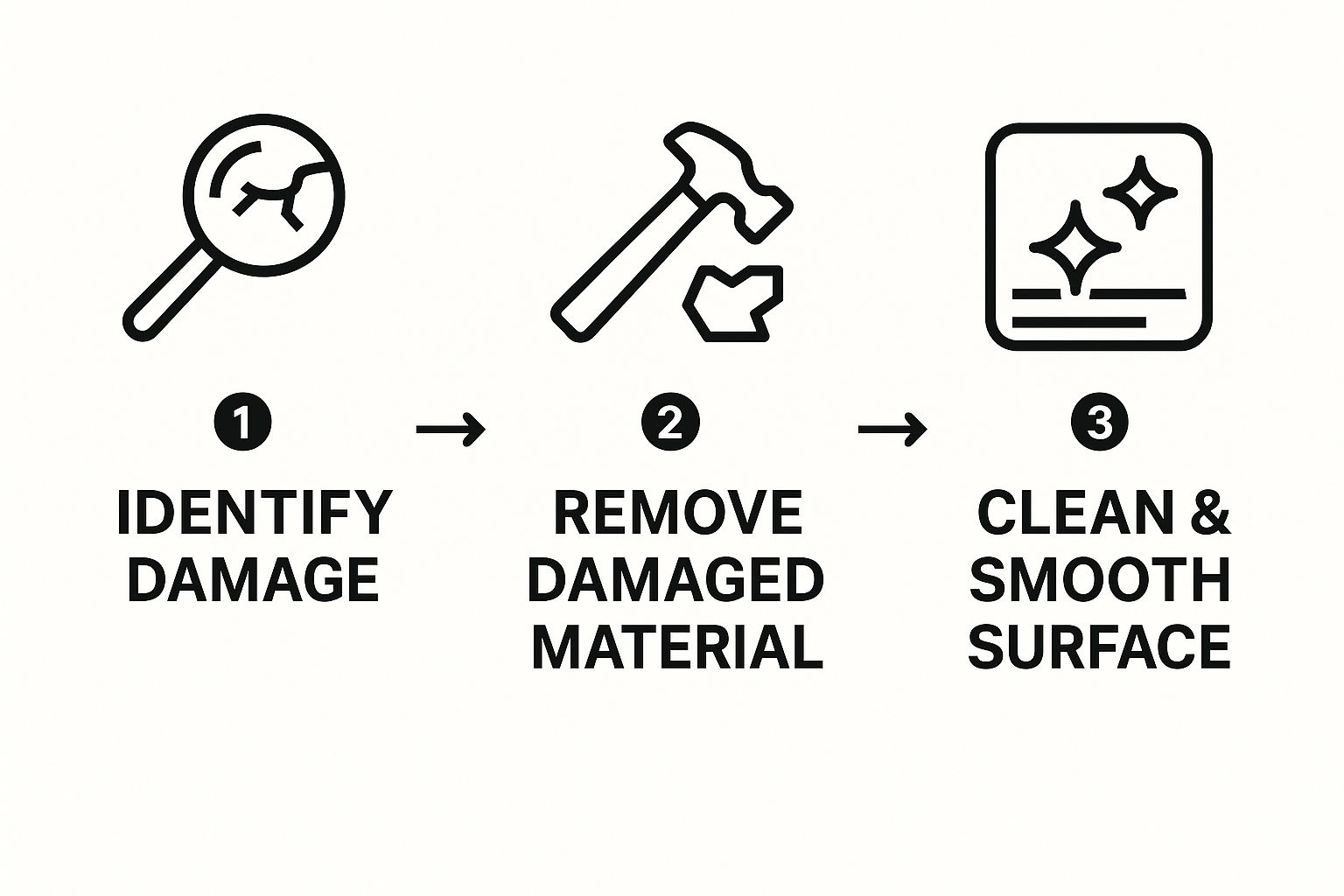
Once all the grinding is done, the area needs a serious cleaning. Wipe it down a few times with acetone on a clean rag. This gets rid of any dust, lingering wax, or oils that could mess up the new resin’s ability to get a death grip on the old fiberglass.
Choosing Your Repair Resin
When it comes to the resin that holds your patch together, you've got two main players: polyester and epoxy. They both work, but they have key differences that can make or break your repair.
Polyester resin is the old-school standard. It's what most production fiberglass boats are built with. It's cheaper and cures faster, which can be a bonus. The downside? It doesn't stick as well to cured polyester (like your hull) and isn't quite as strong or waterproof as its counterpart.
Epoxy, on the other hand, is the gold standard for repairs. It creates a tenacious mechanical bond with almost anything, including old polyester, making it far stronger and more durable. It's also 100% waterproof. The trade-offs are that it costs more and typically takes longer to cure.
Here's a quick breakdown to help you decide:
Fiberglass Repair Material Comparison
| Feature | Polyester Resin | Epoxy Resin |
|---|---|---|
| Bonding Strength | Good, but bonds mechanically to itself. | Excellent, creates a superior mechanical bond to old fiberglass. |
| Water Resistance | Water-resistant, but can be slightly permeable over time. | Completely waterproof, forming an impermeable barrier. |
| Cost | More affordable. | More expensive. |
| Cure Time | Cures relatively quickly. | Cures slowly, often requiring 24 hours or more. |
| Flexibility | More brittle once cured. | More flexible, better able to handle hull stress. |
| Best Use Case | Small cosmetic repairs on polyester hulls. | Structural repairs, repairs below the waterline, and any high-stress area. |
For a structural repair like our gouge, especially if it's anywhere near the waterline, I’d reach for epoxy every single time. The peace of mind is worth the extra cost.
Layering the Fiberglass Patch
Now for the fun part—rebuilding the structure. You’ll need to cut several pieces of fiberglass cloth. Start with a small piece that just fits the very bottom of the beveled area, then cut progressively larger pieces that will overlap onto the surrounding hull.
Mix your resin precisely according to the manufacturer’s directions. This isn't the time to eyeball it. Brush a thin "wet out" coat of resin onto the repair area first, then lay your smallest piece of cloth into the depression. Use a brush or a small squeegee to fully saturate the cloth with resin, working from the center out to push out any air bubbles.
Keep repeating this process, adding the next largest layer of cloth and saturating it, until you’ve built the repair up so it’s sitting just a little bit proud of the hull surface. That slight mound is exactly what you want for the next step.
A Quick Tip on Resin
I've learned this the hard way: when working with epoxy on a warm day, only mix small batches you can use up in 15-20 minutes. Epoxy creates its own heat as it cures (an exothermic reaction), and a big batch in a cup can "kick off" and harden into a hot, useless brick before you're even halfway through your layup.
Fairing for a Smooth Finish
Once the resin has fully cured—which can take anywhere from a few hours to a full day depending on the temperature—it’s time to start fairing. Fairing is just the process of sanding the patch and using a filler to make the repair perfectly smooth and invisible.
Start by knocking down that high spot on your patch with 80-grit sandpaper until it’s almost flush with the hull. Next, mix up a batch of two-part marine epoxy filler. Using a flexible plastic spreader, apply a thin, smooth coat over the whole repair area to fill any low spots, pinholes, or imperfections.
Let the filler cure completely, then sand it smooth again, this time stepping up to 120-grit paper. You’ll probably need to repeat this apply-and-sand process two or three times to get it perfect. The job is done when you can close your eyes, run your hand over the repair, and not feel a single ripple or transition. Once you've reached that point, you're ready for primer and paint.
For a deeper dive, check out our complete guide on how to handle epoxy fiberglass repair.
Specialized Repairs for Wood and Aluminum Hulls
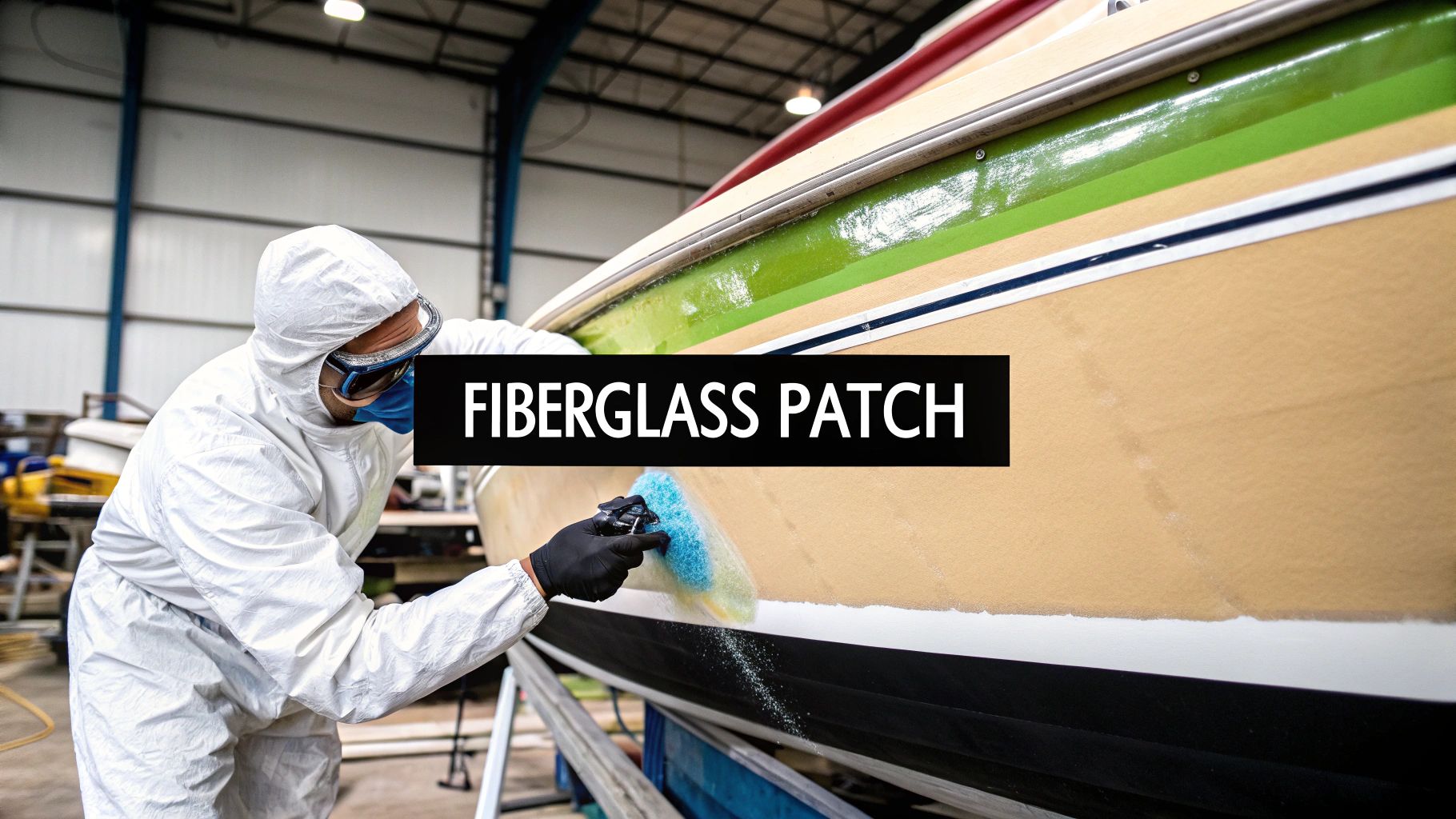
While fiberglass repair is pretty straightforward, tackling a wood or aluminum hull is a whole different ball game. These materials have their own personalities and demand specific techniques. What works for one could be a complete disaster for the other.
This is especially true for the more serious problems. Forget simple scratches—with these classic hull materials, you're usually fighting back against nature itself. That means rot in a wooden boat or corrosion on an aluminum one.
Addressing Rot in a Wooden Hull
Finding a soft spot on a wooden hull can make your stomach drop, but it’s a problem you can absolutely fix. The trick is to be relentless. If you leave even a tiny bit of compromised wood behind, that rot will come right back.
Your first job is to get all the bad stuff out. Grab a chisel, gouge, or even a rotary tool and carefully dig out all the soft, dark, crumbly wood. You have to keep going until you hit solid, healthy timber on every side. It'll look like a gaping wound when you're done, but that clean slate is the only way to get a permanent fix.
Once the cavity is clean, you need to stop any lingering decay dead in its tracks.
-
Saturate with Penetrating Epoxy: Don't skip this. A thin, watery penetrating epoxy will soak deep into the wood fibers around your repair. It stabilizes everything and creates a rock-solid, waterproof base for the new wood to bond to.
-
Create a Scarf Joint: You're not just plugging a hole here. For a repair that’s both strong and almost invisible, you need to cut the edges of the repair area at a long, shallow angle. This is called a scarf joint, and it massively increases the gluing surface, making for a much stronger bond.
With the area prepped and sealed, you can shape a new piece of marine-grade wood with its own matching scarf joint for a perfect fit. Use a thickened structural epoxy to bond it in place, clamp it down tight, and sand it fair once it cures. Done right, this method makes the new wood a seamless part of the hull, restoring its original strength and classic look.
A well-executed scarf joint is the mark of a true craftsman in wooden boat repair. It spreads stress over a much larger area, so you don't get the hard spots that a simple butt joint creates. This ensures the patch flexes naturally right along with the rest of the hull.
Fixing Dents and Punctures in Aluminum
When you're working on an aluminum hull, the two things that matter most are strength and preventing future corrosion. You might be able to hammer out a minor dent from the inside with a dolly and mallet, but a puncture or a deep gouge demands a more serious approach.
Slapping on a simple patch might be tempting, but for any real damage that affects the hull's integrity, professional welding is your best bet for a long-term solution. A certified marine welder can properly fix a crack or weld in a new plate, guaranteeing the repair is just as tough as the original hull.
If you decide to tackle a smaller puncture yourself, your choice of materials is absolutely critical.
Critical Steps for an Aluminum Patch:
- Clean and Prep: The surface has to be perfectly clean. Then, you need to abrade it to give it some "tooth" so the filler can grab on tight.
- Use Aluminum-Specific Filler: This is non-negotiable. You must use an epoxy-based filler made specifically for aluminum. A standard Bondo-type filler can have metals that will react with the hull, kicking off galvanic corrosion that will eat your repair from the inside out.
- Prime Immediately: As soon as you've faired the repair smooth, get a coat of zinc-chromate primer on that bare aluminum right away. This is your shield against oxidation and the key to making sure your topcoat of paint actually sticks.
Cutting corners on these material-specific rules is the quickest way to turn a small fix into a massive corrosion headache later on.
Finishing Your Repair for a Professional Look
Let's be honest, a successful repair is one you can't see. After all that grinding, patching, and layering, this final finishing work is what separates an obvious patch-job from a professional, invisible mend. This isn't just about making your boat look good; it's about protecting all your hard work from the elements.
The goal here is to blend the repaired area so perfectly that even you have a hard time finding it later. It all comes down to a careful process of sanding, priming, and painting to nail that seamless finish.
Sanding and Fairing for a Smooth Surface
Once your patch has fully cured, it's probably going to be a little raised and rough to the touch. The art of making it disappear starts with fairing—the process of sanding and filling until the surface is perfectly smooth and dead-level with the surrounding hull.
Kick things off by sanding with a medium-grit paper, something like 80-grit, just to knock down the high spots and rough edges. Then, you'll want to spread a thin layer of a two-part marine fairing compound over the entire area. Once that's cured, sand it again, but this time step down to a finer 120-grit paper.
Don't be surprised if you have to repeat this fill-and-sand process two or three times. You're trying to fill every last pinhole and tiny imperfection.
Here's a pro tip: Run your hand over the area with your eyes closed. When you can no longer feel even the slightest transition between the patch and the original hull, your fairing work is done. This touch-test is often more accurate than just relying on your eyes.
Priming and Painting Your Repair
With the surface now perfectly faired, the next move is to seal and protect it. A high-quality marine primer is non-negotiable here. It acts as the critical bonding agent between your filler and the topcoat, which is what prevents ugly peeling or blistering down the line.
Apply two or three thin coats of primer. Make sure to sand lightly with 220-grit paper between each coat for the best adhesion.
Now for the part that brings it all together: the final topcoat. Color-matching can be a real headache, especially on an older hull that's seen some sun. If you can, get the original gelcoat or paint code from your boat's manufacturer—it'll save you a lot of guesswork.
For fiberglass boats, using gelcoat is usually your best bet for a durable, factory-like finish. If you're new to working with it, our guide on boat gelcoat repairs is packed with detailed tips.
Whatever you use, apply your paint or gelcoat in thin, even coats. Pay close attention to the product’s instructions for temperature and humidity. Rushing this step is a surefire way to get drips and an uneven finish, which would be a shame after all this work.
The Final Protective Layer
You're almost there. After your topcoat has fully cured—and this could take several days, so be patient—there's one last crucial step. Applying a quality marine wax over the entire repaired section is what locks everything in.
This coat of wax provides a vital layer of UV protection. Why does that matter? It prevents your brand-new finish from fading or oxidizing at a different rate than the rest of the hull, which would make your repair stick out like a sore thumb in a year or two.
This kind of attention to detail is what defines quality marine maintenance. It’s no surprise that the global ship repair and maintenance industry, valued at $37.14 billion, is built on these principles of creating durable, long-lasting finishes. In fact, the market’s projected growth shows just how important proper hull care is worldwide. You can find more industry data from Fortune Business Insights.
A simple coat of wax is the final touch that ensures your repair remains truly invisible and protected for many seasons to come.
Common Questions About Repairing a Boat Hull
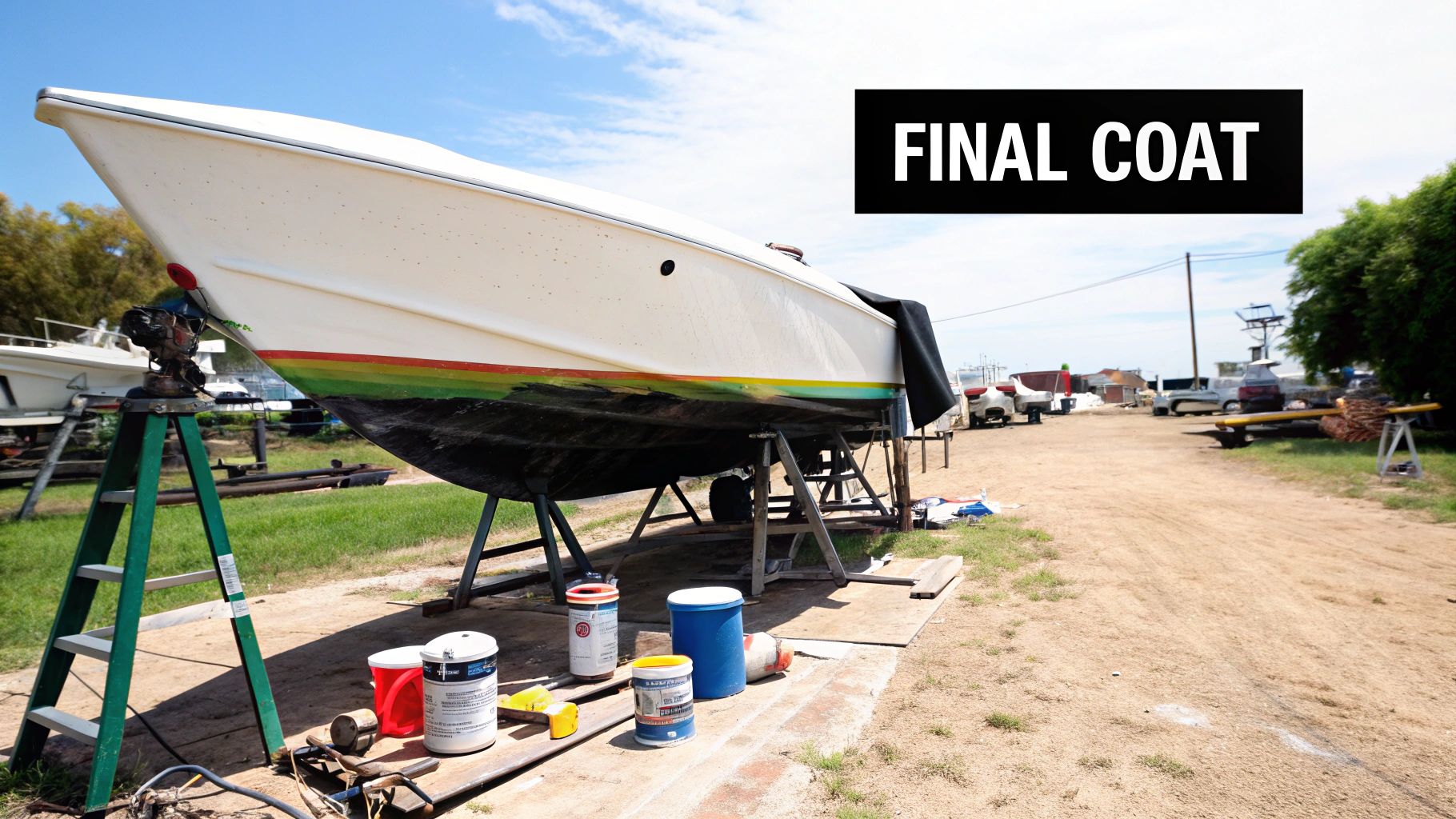
Even with a solid plan, it's easy to second-guess yourself when you're staring down a hull repair. Let's run through a few of the most common questions we hear from fellow boaters. Getting these right can save you a world of hurt down the line.
How Do I Know if a Crack Is Structural or Just Cosmetic?
Figuring this out is the first critical step, and it really comes down to location and depth. You have to know what you're dealing with before you can fix it properly.
- Cosmetic Cracks: Think "spider cracks." These are the fine, web-like crazing you see on the surface. They’re shallow and live only in the gelcoat, not penetrating the actual fiberglass laminate.
- Structural Cracks: These are the serious ones. They're deeper, usually a single, defined line. Pay close attention to high-stress areas like the transom, the keel-hull joint, or around engine mounts. If you can see the crack from both inside and outside the hull, it’s absolutely structural and needs your immediate attention.
A great old-school trick is the "tap test." Grab a plastic mallet or even just the handle of a screwdriver and gently tap the area around the crack. A sharp, solid sound is what you want to hear—that's healthy laminate. A dull thud, however, points to delamination, a sure sign of a structural issue.
Can I Use Automotive Body Filler Like Bondo?
In a word: no. Please don't do this. It’s one of the most frequent—and most expensive—mistakes you can make on a boat repair.
Automotive fillers aren't built for a marine environment. They're porous. The second that repair goes underwater, the filler will act like a sponge, wicking moisture right into the heart of your hull. It’ll swell, crack, and eventually fall out.
Even worse, that trapped moisture can lead to rot or delamination in the surrounding hull, turning your small patch job into a major structural failure. Always, always use a proper two-part marine epoxy filler or a waterproof vinylester fairing compound. They're designed to create a rock-solid, permanent, and completely waterproof bond.
What Is the Ideal Temperature for Applying Epoxy or Resin?
Working with resins is a bit like chemistry class—temperature and humidity are everything. Get them wrong, and your repair might never achieve its full strength. For most epoxies and polyester resins, the sweet spot is between 70-80°F (21-27°C) with low humidity.
Working outside that range is asking for trouble:
- Too cold (below 60°F): The chemical reaction slows to a crawl. The resin might take forever to cure or, worse, never fully harden at all, leaving you with a weak, sticky mess.
- Too hot (above 90°F): The resin can "kick off" way too fast. This exothermic reaction can cause the mix to get hot and harden in your mixing cup before you even have a chance to apply it.
High humidity is another enemy. It can cause a cloudy or waxy film called "amine blush" to form on the surface as it cures. Before you start mixing, do yourself a favor and read the manufacturer's technical data sheet for the exact product you're using. It will tell you the perfect conditions for a successful cure.
At Better Boat, we're here to simplify your maintenance routine with premium products you can trust. From high-strength epoxies to professional-grade cleaning supplies, we have everything you need to protect your investment and enjoy more time on the water. Explore our complete collection and get expert advice at Better Boat.


